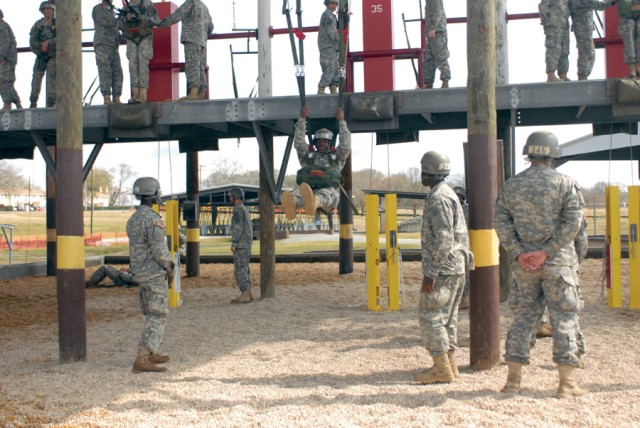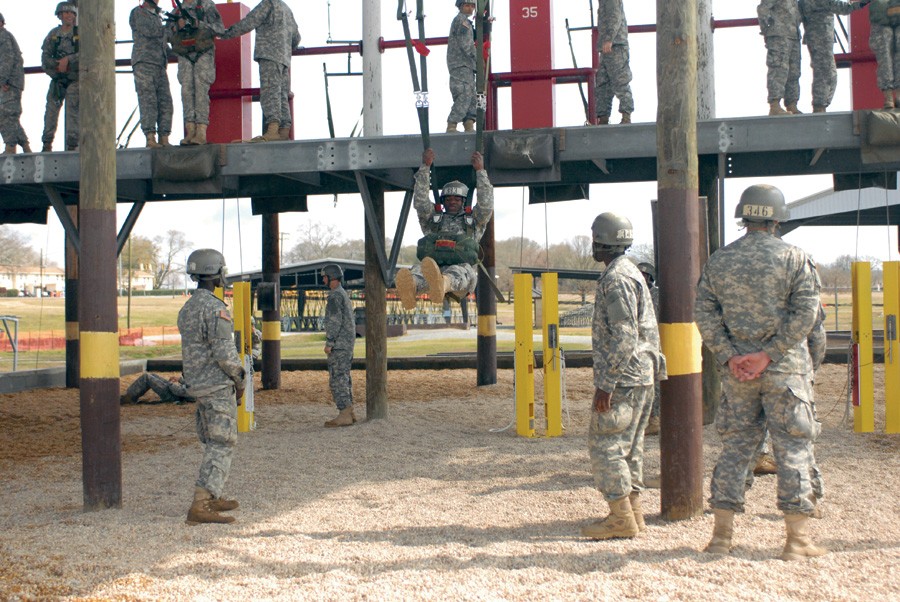With one week of Airborne instruction behind them, students in C Company, 1st Battalion (Airborne), 507th Parachute Infantry Regiment, moved on to training week two, better known as Tower Week.
1SG Christopher Goodrow, C Co. first sergeant, said the second week includes more mock door and 34-foot tower exits. Students exited individually during the first week, but during Tower Week they jump in groups, called mass exits, like the Jump Week plane exits. Students also train on a suspended harness, which teaches them how to control their parachutes during flight, and a swing landing trainer, which provides practice on landing from a 10-foot platform.
Students in this cycle are the first to be simultaneously trained on the T-10 and the new T-11 parachute systems, the first complete parachute system change in more than 50 years. Goodrow said adding the T-11 has resulted in nearly twice as much time spent in the suspended harness and a third more time on the tower.
Because of rain, students weren't released from the 250-foot tower, which company commander CPT Dean Gibson said is likely the most recognizable feature of the school.
Although students are often disappointed about not training on the tower, the tower has specific safety requirements for inclement weather.
However, rigged dummies are released from the 250-foot towers during the malfunctions class, which is the final block of instruction prior to jump one.
Gibson said the demonstration helps ease nervousness because students get to see a practical demonstration of a parachute deployment.
Black Hat SFC Chastity Wassman, who has jumped 108 times, taught the malfunctions class Friday. She said she has never had a malfunction in 13 years of jumping, but it's critical Soldiers know how to react just in case.
"The class teaches them what to do if something goes wrong in the air and teaches them not to overreact," she said. "We tell them exactly what to do so they don't panic."
The instructors have been preparing to teach both systems for six months, and Goodrow said there have been no major problems, so far.
"We've been really impressed with the proficiency the Black Hats have exhibited," he said.
CPT Tarik Fulcher, who completed the Maneuver Captains Career Course before arriving at Airborne School, agreed with the work of the instructors.
"The instruction has been excellent," Fulcher said. "Learning the two parachutes is useful. They've taken great effort to make a seamless transition into teaching both systems."
Although the Armor officer, who is going to 3rd Armor Cavalry Regiment, said he knows he will likely never be assigned to an Airborne unit, he was inspired to be prepared.
"My father and brother are Airborne Rangers," he said. "I'm kind of joining their club, and it's just good to know that if the time calls, I can go"
He said he was inspired by the importance of the cycle's first jump.
"It will be something historic," he said. "When they told us we would be jumping the T-11, I told myself, 'I've got to make it.'"
SPC Megan Potter, who is headed to Fort Bragg, N.C., after Airborne School, also complimented the cadre. Potter moved into C Co. when she didn't pass the parachute landing fall evaluations in a prior class.
"It was really hard to start over," she said. "But the cadre have been great."
Potter said the physical demands of the school are tough for females, but she is determined to get her wings.
"The scariest thing in the world to me is failure, so that's why I decided to go through this again," she said.
And looking forward to Jump Week, the final week, Potter was already thinking like a paratrooper. Her thoughts: "Keep my feet and knees together."


Social Sharing